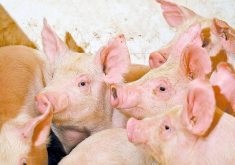Reproductive problems in pigs are complex and requi re a sys temat i c approach to solving them, based on a thorough understanding of the physiology involved, says Dr. Billy Flowers, from North Carolina State University. Speaking at the recent Banff Pork Seminar, he noted that knowing what should normally occur in sows and gilts is essential in order to find out what went wrong.
Production data such as farrowing rate, litter size and return interval combined with the ability to break down records into subsets, for example by parity, season, etc., allow reproductive problems to be identified and investigated. “If we have regular returns to service combined with both poor farrowing rate and litter size, there are specific reasons why this may have happened,” Dr. Flowers says. “This may be poor fertilization rates, high embryonic mortality during the first two weeks of pregnancy or low ovulation rates.”
Read Also

Horns aren’t unlocking anytime soon on livestock transport standards
Standards good enough meet the definition of “humane” animal transportation still vary widely between what what industry wants, what animal rights advocates want and, between the two, what federal regulators decide is good enough.
The most common causes of fertilization failure are poor semen quality and inadequate breeding management, he points out. Consequently, microscopic
Bernie Peet is president of Pork Chain Consulting Ltd. of Lacombe, Alberta, and editor of Western Hog Journal. evaluations of semen should be performed along with a thorough review of estrus detection procedures and breeding regimes.
If fertilization is good but there is high embryonic mortality in the first two weeks after breeding, this is likely due to events from farrowing onwards.
“Around day 12 of pregnancy, the embryos start to produce estrogen and this is the first signal required for pregnancy to be maintained, notes Flowers. “It has been estimated that there needs to be at least five viable embryos in the uterus by day 12 in order to produce enough estrogen for the first pregnancy signal. If there are less than five, then sows never know that they are pregnant and return to estrus in 18 to 21 days.”
Minimize stress
The presence of any social, physical, or environmental stresses during the first two weeks post breeding should be investigated, Dr. Flowers advises. Common ones include rough handling during movement of animals, high ambient temperatures, and competition for food and space among sows in pens.
If farrowing rate and litter size are poor, but return intervals are irregular, this indicates that there were sufficient numbers of embryos to produce the first pregnancy signal at day 12, but not for the second one. “Sometime after day 17 and before day 28 of pregnancy, the developing embryos initiate a second period of estrogen production,” Flowers explains. “It is also assumed that there also needs to be at least five embryos present for this to happen. If there are less than five during this period, then sows usually return to estrus between 28 and 35 days after they were bred.”
This problem is related to management practices during lactation and during the third and fourth week of pregnancy, so these should be evaluated, he says. “It is unlikely that fertilization failure is a contributing factor,” Flowers suggests. “If it was, then embryonic numbers would be low before day 12 and non-pregnant animals would be expected to exhibit regular returns to estrus.”
Normally, good farrowing rate and good litter size go hand in hand and if there is a reproductive problem it tends to affect both. However, sometimes a situation arises where either farrowing rate or litter size is good, but one of the two is poor. In this case it is likely that a specific group of females, or subset of the population, is causing the problem.
“One of the first steps that should be done when farrowing rate and number born alive are moving in opposite directions is to examine the average performance of different groups of animals in the herd,” says Flowers. “Logical comparisons are things such as sows that were bred in the summer versus other seasons or first and second
Farrowing rates
When farrowing rate is good, this means that there were adequate numbers of embryos present for both pregnancy signals to occur. “Low numbers of pigs born alive are caused by things that induce a high incidence of embryonic or fetal death after day 28. In these cases, numbers of mummified fetuses and numbers of stillborn pigs should be examined,” Flowers says. “If the number of mummified fetuses is high, then the problem most likely occurred after day 50 of gestation. In contrast, if the number of stillborn pigs is high, then the problem probably is during the last week of pregnancy or during farrowing itself.”
Whenever numbers of pigs born alive is good and farrowing rate is bad, but return interval is regular, then the problem nearly always is related to a poor management in a subset of sows. “In a situation in which sows show regular returns, the problem involves inadequate breeding regimes or high embryonic mortality during the first two weeks after breeding,” Flowers says. Poor farrowing rate combined with late and irregular returns at day 28 or later may be due to high embryonic mortality between days 12 and 28, so possible causes should be investigated, he continues. “Fortunately, high levels of embryonic or fetal death after day 28 are rare and most likely caused by diseases such as PRRS or leptospirosis which can be readily identified.
“Reproductive problems in sows are the direct result of things that go wrong with the physiology of pregnancy,” Flowers says. “Because these processes occur in a co-ordinated and chronological sequence, examining farrowing rate, number of pigs born alive, and the length of time it takes non-pregnant sows to return to estrus can be used to estimate when the problems are occurring, so that causes and solutions can be found.”














